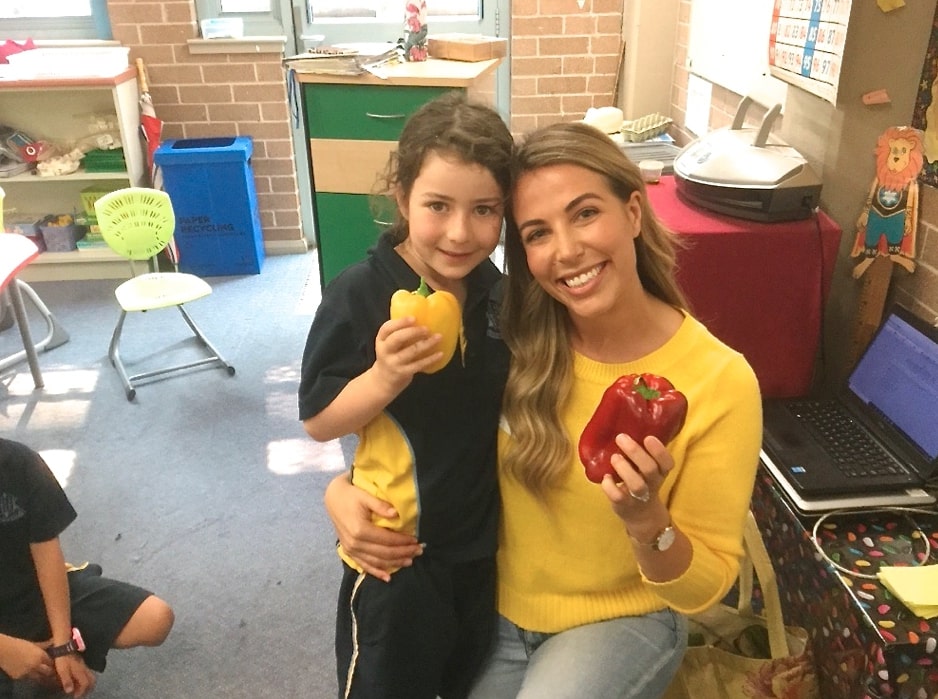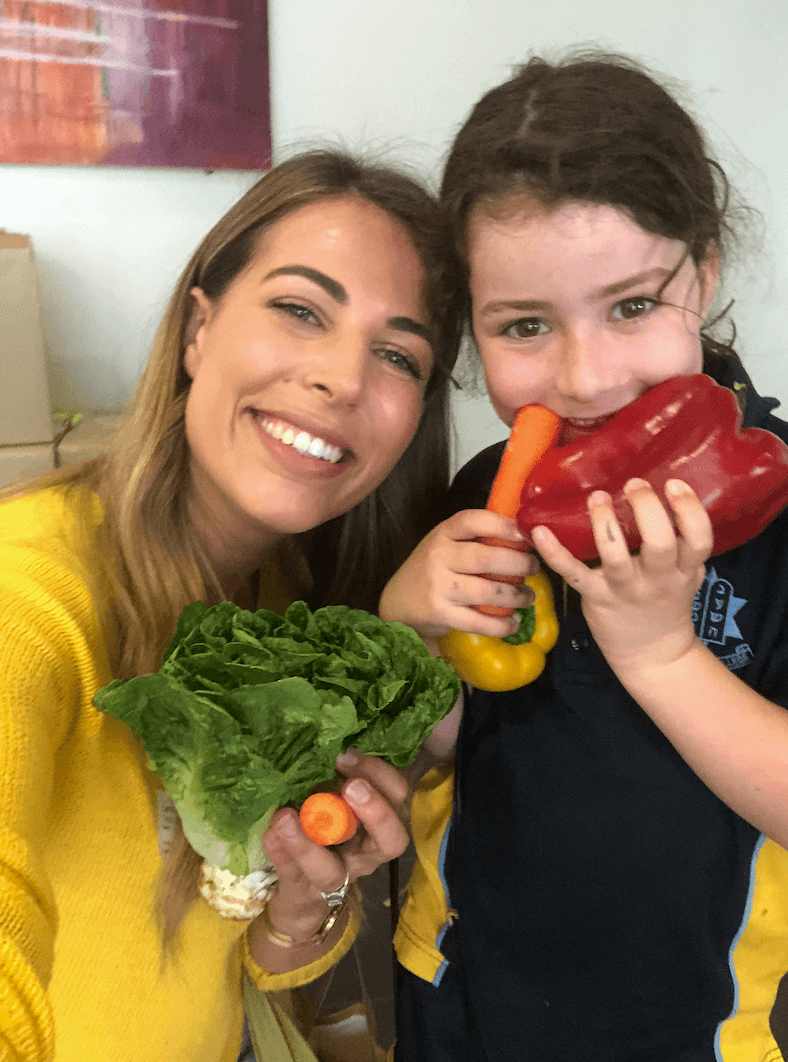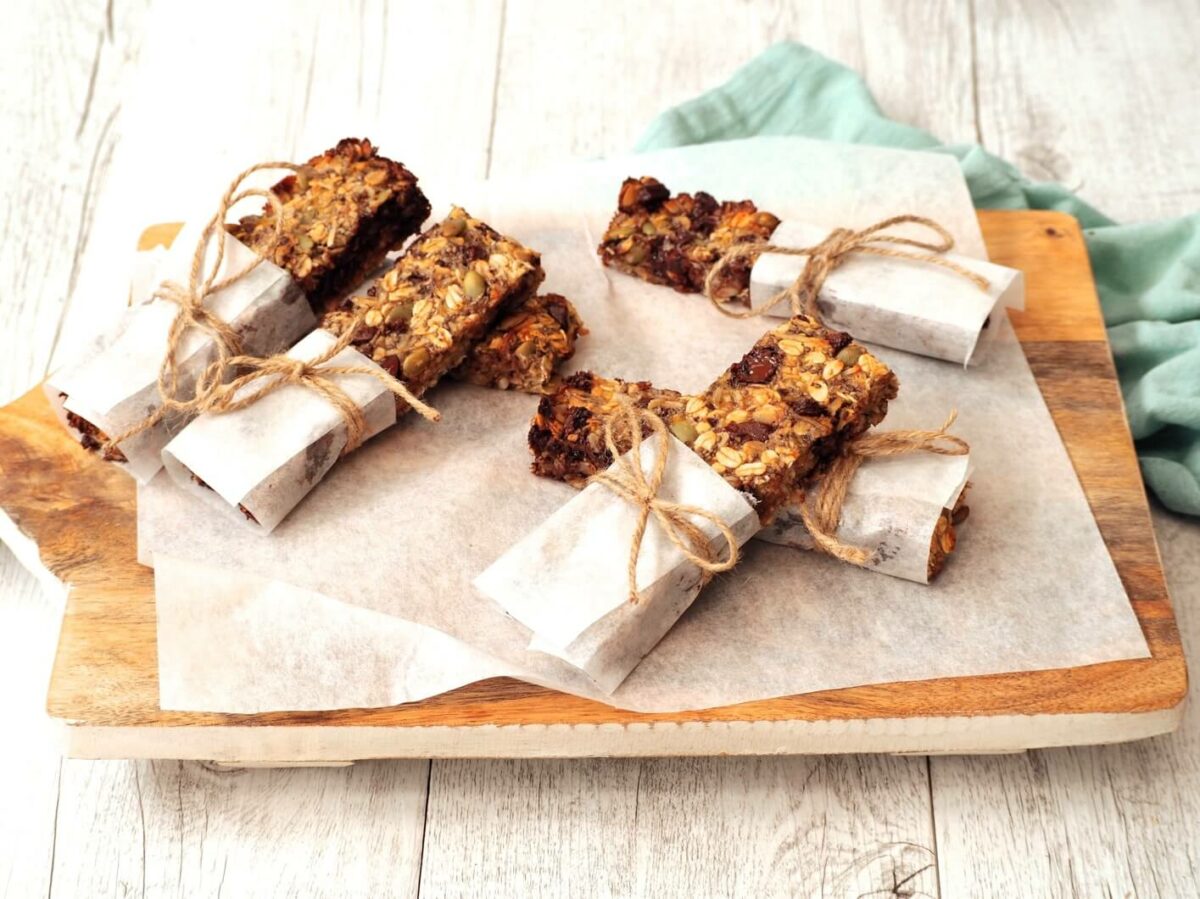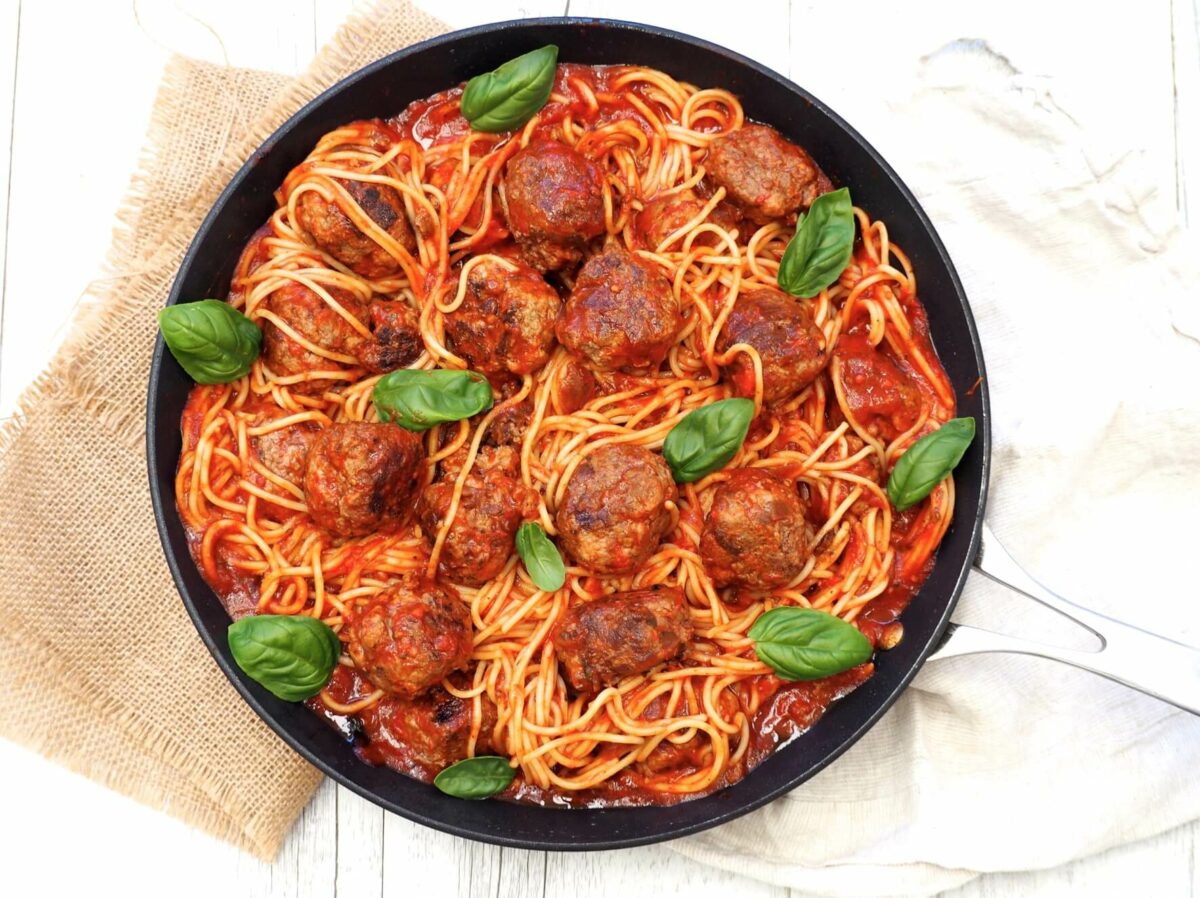Earlier this week I was teaching healthy eating to Kindergarten kids. I was invited to speak at my little cousin’s school to talk to about 36 girls and boys about healthy, balanced eating. In this post, I’m sharing the class lesson outline I created.
While I didn’t get paid to do this (I do get paid a small fee to go into other schools), I thought it was such a good opportunity to have an impact on young kids.
I’ve done workshops and talks for older children (mostly high school) but this was my first time creating health lessons for Kindergarten kids.
Full disclaimer: I’m not a teacher. I’m a dietitian and nutritionist. I’m not a mum yet so my experience with kids is from spending time with my cousins, nephews and nieces… but because I’m a dietitian, you bet I did my research!
I really wanted to prepare properly. So I asked my friends who are teachers for assistance. And researched online. But I couldn’t find exactly what I was looking for online – a balanced, healthy eating class lesson outline created for Kindergarten kids.
And because I believe sharing is caring (something I learned in Kindergarten!) here is the class lesson I ended up creating… in case it helps you in any way.
If you are a teacher, I’d be really grateful for your comments and advice on how to make this class structure better. Feel free to contact me with any further ideas and I can amend this post to make it a better resource.

Related blog posts:
- Should I comment on my daughter’s weight?
- 10 things to avoid to raise children with a healthy relationship with food
My healthy eating class lesson for Kindergarten kids
Here is my class structure when I taught kids aged 6-7 about being healthy:
- Students: 36 Kindergarten kids, mixed-sex
- Time: 45-minute class length
- Start time 8:45 am (I think this helped with engagement)
- Other details: I brought with me a bag of vegetables, fruit and food as props, but obviously nothing that could be a good allergen such as nuts. I wore casual clothes (a bright yellow jumper, jeans and sneakers) to feel more relatable and fun. I don’t know if this matters but it felt right for me.
Section 1. THE BASICS
Intro: I started by introducing myself by my first name (more casual then Mrs. Cohen) and I explained that I help people eat healthily for my job. This means that I can help sick people in hospitals to feel better, guide healthy people to feel happier and support athletes to play even better and be stronger or run faster.
Back to basics: I explained that lots of things can affect how healthy you are… like what you eat, how you think and other things like whether you put on sunscreen to protect you from the sun.
Living things need to eat to stay alive. Like your pet at home needs to be fed.
Why should we eat a healthy diet?: Eating healthier foods can help you feel happy and strong so you can do the things you love. Being healthy is about having energy so you can concentrate at school, play with your friends and do your favourite activities. It can help you grow strong muscles and do amazing things with your body.
(Note: I did not talk about weight at all. Because real health isn’t about what someone weighs, it’s about so much more).

Section 2. HUNGER
What is hunger?: I asked the kids… And then let them explain it to me.
- Why do you think you get hungry?
- What does hunger feel like to you?
- Can you remember when you last felt hungry?
I explained that being hungry is a natural and amazing thing. It’s your body’s way of telling you when you need more fuel. And it’s really important to listen to your hunger. We identified what hunger feels like. Some answers included: “strange feeling in my tummy”, “sometimes I get hangry when I don’t eat”. “I get tired and sleepy”.
Section 3. BALANCED EATING
I talk about how eating a range of balanced food makes you feel your best.
- I asked: Do you think it would be healthy if you only ate lollies… Or healthy if you only eat carrots? Why do you think this is?
Eating a healthy balanced diet means our bodies get a mix of all the nutrients it needs – giving us the energy to feel strong and feel happy.
Our bodies are constantly talking to us and giving us clues about how to look after it. Just like when you feel tired, you know it’s time to go to sleep or you know when it’s time to go to the toilet…
I asked: What happens when we eat too many lollies? One little boy explained that over Halloween, his brother ate too much candy and threw up because he felt so sick. I agreed that this is possible.
I explained that we want to eat mostly healthy ‘everyday’ foods but that having lollies ‘sometimes’ was healthy too because that’s balance.

Section 4. EAT THE RAINBOW
I asked the kids: Does anyone know: what is a ‘nutrient’? One little girl explained it’s something in food that is good for us. I agreed. (…and I was impressed!)
Then I asked if you can see nutrients in food? The kids didn’t think you could see nutrients but then I explained that you can see some nutrients! Different colours in food show us different nutrients.
How to eat the rainbow
I had a bag full of fruits and vegetables… One for each colour of the rainbow. I asked six volunteers to come stand next to me in a row, one by one. Each child got to hold onto the vegetable/fruit. And I asked the volunteer to name the item and tell me what colour it is… Then we talked about what each colour was useful for (e.g. red in the same colour as your heart, and it’s good for your heart).
- Red (red capsicum, red apple, tomatoes)
- Orange (carrot, orange)
- Yellow (banana, yellow capsicum, tinned corn)
- Green (lettuce, cucumber, zucchini)
- Blue/Purple ((blueberries, eggplant, purple cabbage, red onion, radish, beetroot)
- Brown (mushrooms, onions, beans)
I brought a bag of ‘party style’ lollies with me. I showed them all the colours and asked if ‘eating the rainbow’ was the same for lollies. They knew it’s not the same! :P
Count colours
I asked them to play a game next time they eat – to count the colours on their plate. I asked when was the last time they ate food? How many colours can they remember eating?
Note: If I had time, I would have asked the kids to draw a plate of food and include as many different coloured foods as they could think of.
- How many vegetables should you eat every day?
I got the kids to hold up their fists to the air, like superheroes. I explained that one serve of fruit or vegetables was the size of their fist. As they get bigger, their fist will get bigger.
We talked about how when you’re grown up, it’s awesome to eat 5+ veg and 2+ fruit a day. I didn’t want to confuse them by talking about the recommendation for their age group.

Section 5. TRYING NEW FOODS
I got the kids to stick out their tongues like a lion. They laughed. I explained that your tongue has taste buds, that help you taste the food. And your nose smells different foods too.
As you get older, your taste buds change and develop. So just because you didn’t like a food last time you ate it, doesn’t mean you won’t like it now.
I said you don’t need to finish a bowl of food you don’t want to but it’s a good idea to keep trying foods you didn’t like before in case you now love them.
Section 6. ‘EVERYDAY’ VS ‘SOMETIMES’ FOOD + DRINKING WATER
We talked about everyday foods. I.e. foods you can eat every day to be healthy. I got them to come up with ideas on what was an ‘everyday’ food. e.g. fruits, vegetables, whole grains, nuts, seeds, yoghurt…
I explained that eating lollies every day won’t make you feel good. We talked about what ‘sometimes’ food is e.g. lollies, chocolate, cake, cookies, soft drink etc. I explained that this is the kind of food you enjoy at parties with your friends and family.
We talked about why drinking water was healthier than other drinks. I got them to talk about other drinks like soft drinks and juice. I explained that these are ‘sometimes’ drinks, the kind of thing we have on special occasions.
I reiterated by listening to your body was the best thing to do.
Section 7. MOVING WITH ENJOYMENT
I explained that moving your body – gives you energy and helps you have fun and be strong. I said that moving your body should feel good. And that the best way to move your body is in a way that feels fun.
I asked them how they like to move their body in a fun way. We talked about fun ways to be active.
Section 8. BODY RESPECT + GRATITUDE
According to research, little girls become aware of the fact that thinness is desirable at age six. This makes me so sad. But it’s also the reason I wanted to have this conversation.
We talked about respecting your body and being grateful for what it can do. I explained that different bodies look different and each body has a different strength. We need to take care of our body and appreciate the wonderful things our own body can do. And also, to respect that other people’s bodies will look and be different from ours – and this is what makes us all special.
I asked for a volunteer to come up and tell me what she was grateful for her body for doing.
She said she was grateful for the colours she could see, that her legs could take her places and that her body helped her learn. It was awesome. I felt proud.
Additional (my backup talking points)…
If I had too much time on my hand, I had a few questions I was going to ask:
- What healthy food do you like to eat?
- What are popular foods made from: ketchup, pizza, nuggets, chips, lollies etc.
Question time
For the last 5 minutes of the class, I asked if anyone had questions. There were lots of questions! And they had the best questions. Here are a few:
- Yellow and red and green capsicums are different colours. Does that mean they have different nutrients? Amazing question!
- White and brown are colours. So If my plate has mashed potatoes, chicken and white rice, does this mean I’m eating the rainbow?
- How did you become someone who teaches people how to eat healthily?
- My dad said that salmon and fish have something special in them that we can’t get from anywhere else. Is this right?
Great questions, right?! I was so impressed.
Related blog posts:
Should I comment on my daughter’s weight?
10 things to avoid to raise children with a healthy relationship with food
How to teach your kids to eat healthily
Preparing a healthy food topic for Kindergarten kids
Teaching kids about healthy eating truly feels rewarding.
If you’re going to teach a class or kids about healthy eating, I really hope it goes so well and that my healthy eating lesson outline did help with the prep.
Big love from me,
Lyndi
xx
P.s. If you want to feed your family healthy meals – eat less takeaway – and take the guesswork of out grocery shopping, check out Back to Basics.
It’s filled with family-friendly recipes and it’ll save you lots of time.